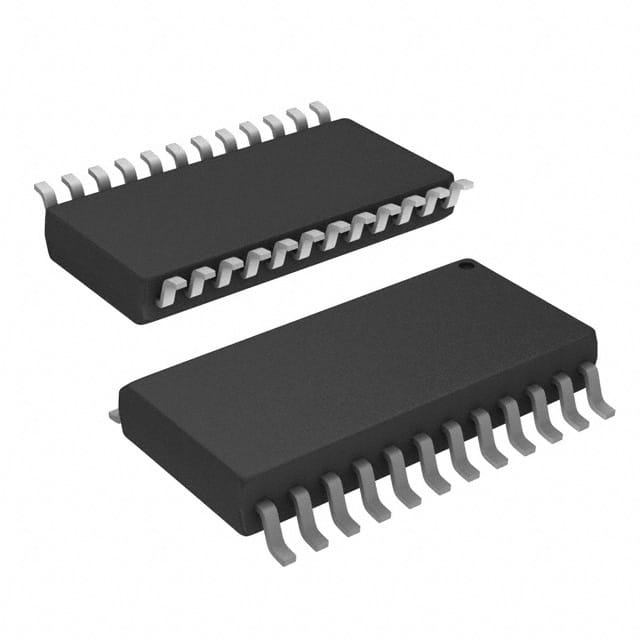AD5206BR50
Product Overview
- Category: Integrated Circuit (IC)
- Use: Digital Potentiometer
- Characteristics: 6-channel, 8-bit resolution, non-volatile memory, I2C interface
- Package: 24-lead SOIC (Small Outline Integrated Circuit)
- Essence: AD5206BR50 is a digital potentiometer IC used for electronic circuit control and adjustment. It provides a programmable resistance that can be digitally controlled through an I2C interface.
- Packaging/Quantity: The AD5206BR50 is available in a 24-lead SOIC package and is typically sold in reels of 250 units.
Specifications
- Number of Channels: 6
- Resolution: 8-bit (256 steps)
- Resistance Range: 0 to 50 kΩ
- Interface: I2C
- Operating Voltage: 2.7V to 5.5V
- Temperature Range: -40°C to +125°C
Detailed Pin Configuration
The AD5206BR50 has a total of 24 pins. The pin configuration is as follows:
- VDD: Power supply voltage
- SDA: Serial data input/output for I2C communication
- SCL: Serial clock input for I2C communication
- GND: Ground
- A0: Address bit 0
- A1: Address bit 1
- A2: Address bit 2
- RST: Reset input
- WP: Write protect input
- VSS: Negative power supply voltage
- W0: Terminal Wiper 0
- B0: Terminal B 0
- A0: Terminal A 0
- W1: Terminal Wiper 1
- B1: Terminal B 1
- A1: Terminal A 1
- W2: Terminal Wiper 2
- B2: Terminal B 2
- A2: Terminal A 2
- W3: Terminal Wiper 3
- B3: Terminal B 3
- A3: Terminal A 3
- W4: Terminal Wiper 4
- B4: Terminal B 4
Functional Features
- Digital Control: The AD5206BR50 allows for digital control of resistance values, providing precise adjustment capabilities.
- Non-Volatile Memory: The IC features non-volatile memory, allowing it to retain its programmed resistance values even when power is removed.
- I2C Interface: The I2C interface enables easy communication and control with other devices in the circuit.
- Multiple Channels: With 6 channels, the AD5206BR50 can independently control multiple resistances.
Advantages and Disadvantages
Advantages
- Precise digital control of resistance values
- Non-volatile memory ensures retention of programmed values
- Easy integration with other devices through the I2C interface
- Multiple channels for independent control
Disadvantages
- Limited resolution (8-bit)
- Restricted resistance range (0 to 50 kΩ)
Working Principles
The AD5206BR50 utilizes a combination of digital-to-analog converters (DACs) and switches to create a programmable resistance network. The digital control signals received through the I2C interface are converted into analog voltages, which are then used to adjust the resistance values at each channel. The non-volatile memory ensures that the programmed resistance values are retained even when power is removed.
Detailed Application Field Plans
The AD5206BR50 is commonly used in various applications that require precise resistance control. Some of the potential application fields include:
- Audio Equipment: The IC can be used to adjust volume levels, tone controls, and equalizers in audio systems.
- Industrial Automation: It can be employed for calibration and adjustment purposes in industrial control systems.
- Test and Measurement Instruments: The digital potentiometer can be utilized for fine-tuning and calibration in test equipment.
- Medical Devices: It can be integrated into medical devices for precise control of parameters such as flow rates or signal amplification.
- Automotive Electronics: The IC can be used for controlling various electronic functions in vehicles, such as climate control or audio systems.
Detailed and Complete Alternative Models
- AD5204: 4-channel digital potentiometer with similar specifications
- MCP4131: 6-channel digital potentiometer with similar characteristics
- MAX5486: 6-channel digital potentiometer with extended resistance range
These alternative models offer similar functionality and can be considered as alternatives to the AD5206BR50 based on specific requirements.
Word count: 529 words
Senaraikan 10 soalan dan jawapan biasa yang berkaitan dengan aplikasi AD5206BR50 dalam penyelesaian teknikal
Sure! Here are 10 common questions and answers related to the application of AD5206BR50 in technical solutions:
Q: What is AD5206BR50? A: AD5206BR50 is a digital potentiometer IC (Integrated Circuit) with 6 channels, each having a resolution of 256 steps.
Q: What is the purpose of using AD5206BR50 in technical solutions? A: AD5206BR50 can be used to digitally control resistance in various applications, such as volume control, gain adjustment, and calibration.
Q: How does AD5206BR50 communicate with other devices? A: AD5206BR50 uses a standard SPI (Serial Peripheral Interface) protocol for communication with microcontrollers or other digital devices.
Q: Can AD5206BR50 be used in both analog and digital circuits? A: Yes, AD5206BR50 can be used in both analog and digital circuits as it provides a digitally controlled variable resistance.
Q: What is the maximum resistance value that AD5206BR50 can provide? A: AD5206BR50 has a maximum resistance value of 50 kΩ (kilo-ohms) for each channel.
Q: Is AD5206BR50 suitable for high precision applications? A: Yes, AD5206BR50 offers good accuracy and linearity, making it suitable for many high precision applications.
Q: Can AD5206BR50 handle high voltage levels? A: No, AD5206BR50 is designed to operate at low voltage levels typically found in digital circuits (up to 5V).
Q: Does AD5206BR50 have non-volatile memory? A: Yes, AD5206BR50 has non-volatile memory, which allows it to retain its settings even when power is removed.
Q: Can AD5206BR50 be cascaded to increase the number of channels? A: Yes, multiple AD5206BR50 ICs can be cascaded together to increase the number of available channels.
Q: Are there any application examples where AD5206BR50 is commonly used? A: Yes, AD5206BR50 is commonly used in audio equipment, instrumentation, test and measurement devices, and industrial control systems.
Please note that these answers are general and may vary depending on specific use cases and requirements.


